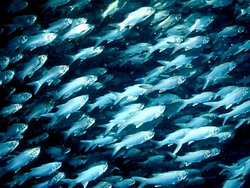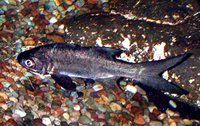Threadfin
|
|
| Threadfin | ||||||||||
|---|---|---|---|---|---|---|---|---|---|---|
 Sixfinger threadfins (Polydactylus sexfilis) | ||||||||||
| Scientific classification | ||||||||||
| ||||||||||
| Genera | ||||||||||
|
Eleutheronema |
Threadfins are silvery grey perciform marine fish of the family Polynemidae. Found in tropical to subtropical waters throughout the world, the threadfin family contains nine genera and 33 species. An unrelated species sometimes known by the name threadfin, Alectis indicus, is properly known as the Indian threadfish (family Carangidae).
Ranging in length from 20 centimetres in the black-finned threadfin (Polydactylus nigripinnis) to 200 centimetres in fourfinger threadfins (Eleutheronema tetradactylum) and giant African threadfins (Polydactylus quadrifilis), threadfins are both important to commercial fisheries as a food fish, and popular among anglers. Their habit of forming large schools makes the threadfins a reliable and economic catch.
Their bodies are elongate and fusiform, with spinous and soft dorsal fins widely separate. Their tail fins are large and deeply forked; this is an indication of their speed and agility. The mouth is large and inferior; a blunt snout projects far ahead. The jaws and palate possess bands of villiform (fibrous) teeth. The most distinguishing feature of the threadfins are their pectoral fins: they are composed of two distinct sections, the lower of which consisting of between 3-7 long, thread-like independent rays. In Polynemus species there may be up to 15 of these modified rays.
In some species, such as the royal threadfin (Pentanemus quinquarius), the thread-like rays may extent well past the tail fin. This feature explains both the common name threadfin and the family name Polynemidae, from the Greek poly meaning "many" and nema meaning "filament." Similar species, such as the mullets (family Mugilidae) and milkfish (family Chanidae) can be easily distinguished from threadfins by their lack of filamentous pectoral rays.
Threadfins frequent open, shallow water in areas with muddy, sandy or silty bottoms; they are rarely glimpsed at reefs. Their filamentous pectoral rays are thought to serve as tactile structures, helping the fish to find prey within the sediments. Noted for being euryhaline, threadfins are able to tolerate a wide range of salinity levels. This attribute allows threadfins to enter estuaries and even rivers. They feed primarily on crustaceans and smaller fish.
Presumed to be pelagic spawners, threadfins probably release many tiny buoyant eggs into the water column which then become part of the plankton. The eggs float freely with the currents until hatching. In Hawaii, sixfinger threadfins (Polydactylus sexfilis) are the subject of experimental aquaculture; they may soon alleviate pressures on wild stocks and lessen the state's dependence on imported fish.
See also: list of fish common names, list of fish families
External links
- FishBase entry on Polynemidae (http://www.fishbase.org/Summary/FamilySummary.cfm?ID=361)
- Offshore aquaculture project yields a traditional Hawaiian delicacy (http://www.oar.noaa.gov/spotlite/archive/spot_hawaii.html)

